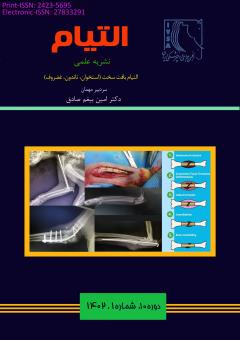معاینه ارتوپدی اندام خلفی در دام کوچک
محورهای موضوعی : علوم جراحی دامپزشکی شامل جراحی های بافت های سخت و نرمحمیدرضا مسلمی 1 , مهشید فرمند 2
1 - استادیار، گروه علوم درمانگاهی، دانشکده دامپزشکی، دانشگاه سمنان، سمنان، ایران
2 - دانشجو، دانشکده دامپزشکی، دانشگاه سمنان، سمنان، ایران
کلید واژه: معاینه ارتوپدی, اندام خلفی, دام کوچک,
چکیده مقاله :
لنگش یک مشکل رایج در حیوانات کوچک است. در بیشتر موارد، اندام آسیب دیده شناسایی می شود، اما منشاء دقیق آن در اندام می تواند نامشخص و چالش برانگیز باقی بماند. معاینه ارتوپدی نقش مهمی در تعیین محل لنگش، تشخیص علت و یافتن درمان مناسب دارد. تشخیص زود هنگام مشکلات اسکلتی- عضلانی، برای بکارگیری درمان مناسب یا استفاده از روش های پیشگیرانه در اوایل پیشرفت بیماری، حیاتی است. معاینه کامل ارتوپدی باید برای هر بیمار با علائم ناهنجاری های اسکلتی عضلانی انجام شود. یک رویکرد سیستماتیک در معاینه ارتوپدی برای اطمینان از ارزیابی تمام ساختارها و از دست نرفتن بخشی از آن مهم است. هدف از معاینه ارتوپدی ارزیابی بیمار از نظر وجود یا عدم وجود بیماری و شناسایی علت ایجاد آن است. معاینه ارتوپدی شامل اخذ تاریخچه، مشاهده راه رفتن، تحلیل و ارزیابی گام و معاینه بالینی بیمار می باشد. قبل از شروع معاینه بالینی، سابقه لنگش، تشخیص و درمان های قبلی و میزان تأثیر آنها، وجود هر بیماری سیستمیک دیگر و رژیم غذایی باید ثبت شود. همچنین زمان شروع و علل احتمالی لنگش و زمان پیشرفت آن، به تشخیص بهتر کمک می کند. مشاهده راه رفتن بیمار با سرعت های مختلف و از جهت های متفاوت بسیار مهم است. مشاهده بالا و پایین رفتن بیمار از پله و سطح شیب دار نیز می تواند مفید باشد. درک حرکت و راه رفتن برای تشخیص بسیاری از مشکلات اسکلتی- عضلانی و عصبی ضروری است. قبل از هر گونه معاینه ارتوپدی یا عصبی، ارزیابی راه رفتن باید انجام شود. ارزیابی راه رفتن می تواند برای روشن ساختن این نکته که کدام اندام تحت تاثیر قرار گرفته، مفید باشد. در نهایت اقدام به انجام معاینه بالینی ارتوپدی در حیوان می شود. در این مقاله به نحوه معاینه بالینی سیستماتیک در اندام حرکتی خلفی پرداخته می شود.
Lameness is a common complaint in small animal medicine. Orthopedic examination is performed by visual and manual assessment of the patient. In most cases, the affected extremity is identified, but the exact origin of that extremity remains obscure and sometimes difficult. Orthopedic examination plays an important role in determining the location of lameness, diagnosing its cause, and finding appropriate treatment. Early diagnosis of musculoskeletal problems is very important to apply appropriate treatment and preventive measures in the early stages of disease progression. Patients presenting with symptoms of musculoskeletal abnormalities should undergo a complete orthopedic examination. A systematic approach to orthopedic examination is important to assess all structures and ensure that no part is missed. The purpose of orthopedic examination is to assess the presence or absence of the disease in the patient and determine the causes of its occurrence. The orthopedic examination includes history taking, walking observation, step analysis and evaluation, and clinical examination of the patient. A history of lameness, previous diagnoses and treatments and their effects, the presence of other systemic diseases, and diet should be documented before the initiation of clinical examination. The time of onset of lameness, possible causes, and the timing of progression also help in a better diagnosis. It is very important to observe the patient walking from different directions at different speeds. Observing the patient going up and down stairs and ramps may also help. Understanding movement and gait is important for diagnosing many musculoskeletal and neurological problems. Gait analysis should be performed before any orthopedic or neurological examination. Gait analysis can help further clarify which limb is affected. Finally, an orthopedic clinical examination of the animal is performed. This article describes methods for clinical examination of the hind limb.
1. Duerr FM. Canine lameness. John Wiley & Sons, Inc. 2020.
2. Arthurs G. Orthopaedic examination of the dog 2. Pelvic limb. In Practice. 2011;33:172–79.
3. Jeffrey N: Neurological examination of dogs 1. Techniques. In Practice. 2001;23:118-30.
4. Scott H. Non-traumatic causes of lameness in the hindlimb of the growing dog. In Practice. 1999;21(4): 176-88.
5. Di Dona F, Della Valle G, Fatone G. Patellar luxation in dogs. Veterinary Medicine: Research and Reports. 2018;9 23–32.
6. Witte P, Scott H. Investigation of lameness in dogs 2. Hindlimb. In Practice. 2011;33:58-66.
7. Houlton JE. A problem orientated approach to the diagnosis of joint disease. In BSAVA Manual of Small Animal Arthrology. Eds J. E. F. Houlton & R. W. Collinson. BSAVA Publications. 1994.
8. Ginja M, Gaspar AR, Ginja C. Emerging insights into the genetic basis of canine hip dysplasia. Veterinary Medicine: Research and Reports. 2015;6:193–202.
9. Fossum TW, Cho J, Dewey CW, Hayashi K, Huntingford JL, MacPhail CM, et al. Small animal surgery. Philadelphia, PA : Elsevier, Inc. 2019.
10. Schachner ER, Lopez MJ. Diagnosis, prevention, and management of canine hip dysplasia: a review. Veterinary Medicine: Research and Reports. 2015;6:181–92.


